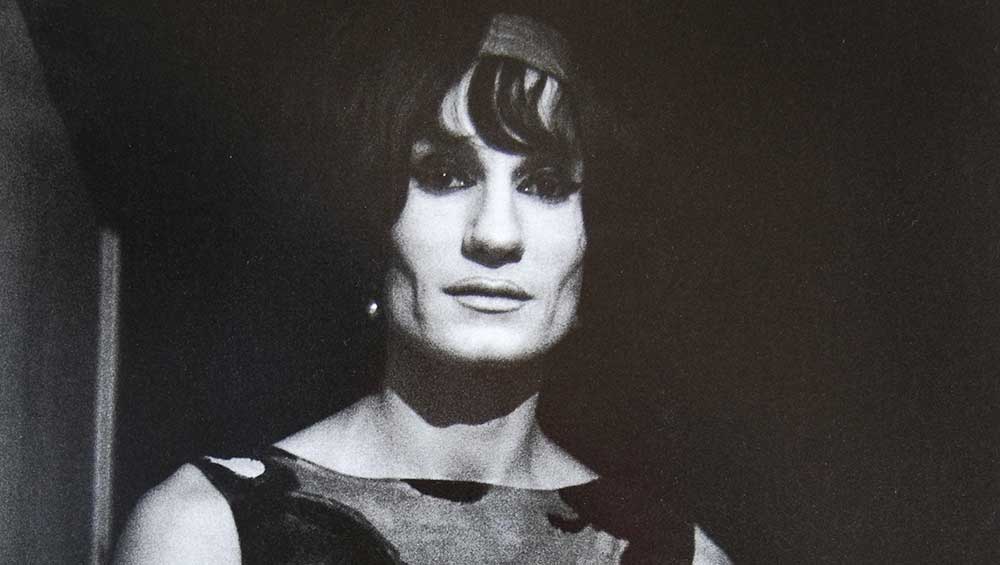
Lisetta Carmi, I travestiti, Dalida, Genoa, 1965-67 (detail). © Martini & Ronchetti. Courtesy Archivio Lisetta Carmi.
Estorick Collection, London
20 September – 17 December 2023
by ANNA McNAY
Born the third child after two brothers, Lisetta Carmi (1924-2022) grew up wanting – and believing it was expected of her – to be a boy. It was perhaps this feeling of not-quite-belonging that let her develop such deep empathy; she understood the human condition, and felt with, not just for, the underlings and the oppressed. Although a lauded concert pianist, Carmi was to walk away from this profession at the age of 36 to embark on an 18-year career as a photographer – untaught, except by life.
This about-turn was precipitated by Carmi’s profound sense of justice. In 1960, Genoa saw many popular demonstrations against the rise of its neo-fascist political party, and Carmi wanted to participate. Her piano tutor had other ideas, however, and he tried to dissuade her on the grounds that she might damage her hands. To this Carmi responded: “If my hands are more important than humanity, I’ll give up playing.” And so she did. She then encountered photography almost by chance. A friend invited her to accompany him on a research trip in Puglia, and she took along her cheap camera. On return home to Genoa, Carmi had nine rolls of film developed. Her friends responded enthusiastically to her snapshots, commenting that they looked like photographs by Henri Cartier-Bresson. The rest, as they say, is history.

Lisetta Carmi, Genoa - Port, 1964. © Martini & Ronchetti. Courtesy Archivio Lisetta Carmi.
In an interview filmed in 2017, Carmi reflected, “When I was a photographer, I was mostly interested in things of strength,” and this is certainly a thread that can be traced through her different series. In the Estorick Collection’s mini retrospective, for example, one of the two galleries (in which this fascinating interview is also being screened on a loop) includes examples from series concerned with hard labour: Port of Genoa (1964), Italsider (1962-64) (a steelworks in Genoa) and Cork Factory Calangianus (1964-76) (the first factory in Sardinia to employ female workers), in which she captures a stark geometric beauty in the diamond-shaped criss-crossing of cranes, the stacks of bricks and timber, rotators and cogs, and rows of workers.

Lisetta Carmi, Italsider, Genoa, 1962-64. © Martini & Ronchetti. Courtesy Archivio Lisetta Carmi.
At the same time, however, there is something intensely personal about Carmi’s works: human ants dwarfed by gigantic machinery; the proud, well-dressed foreman seen against the unscrubbed, working-class masses – many of whom look like underaged labour; and the full gamut of facial expressions captured, from concentrated frown to cheeky grin to exhausted, vacant gaze. Carmi was an outsider on many levels: a woman in an androcentric world and a middle-class Jewish one at that. To gain access to the docks, for example, she had to pretend to be the cousin of one of the stevedores. Wherever she went, however, she inveigled her way in, and even when a minor deception or white lie was necessary, once over the threshold, she became part of the scenery and presented the world from within, while still managing to raise objective, anti-bourgeois challenges.
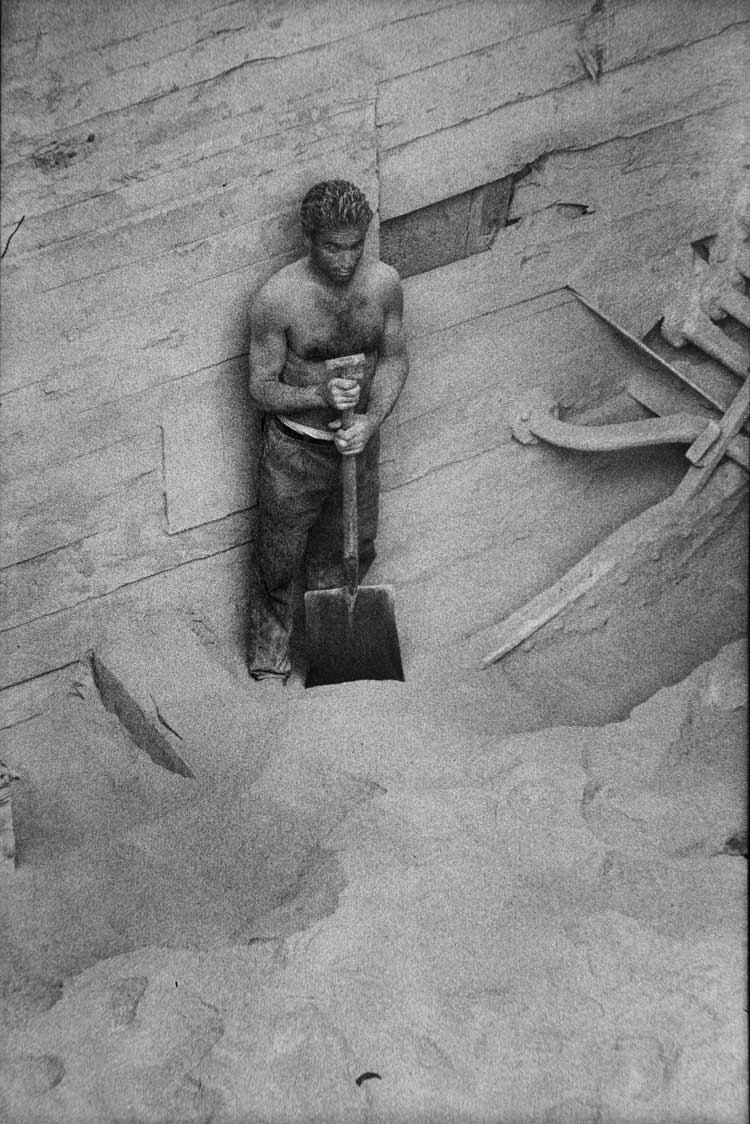
Lisetta Carmi, Genoa - Port, 1964. © Martini & Ronchetti. Courtesy Archivio Lisetta Carmi.
Another amazing series about labour – literally – and strength is Childbirth (1968). Although not included on the exhibition walls, it is discussed and illustrated in the interview. Her photos show a baby crowning, emerging, being born and cut free from the body of its mother, all taken head on. There is a tender intimacy, a huge sense of privilege to be able to share in this private and yet universal moment, and a peerless bravery to this work.
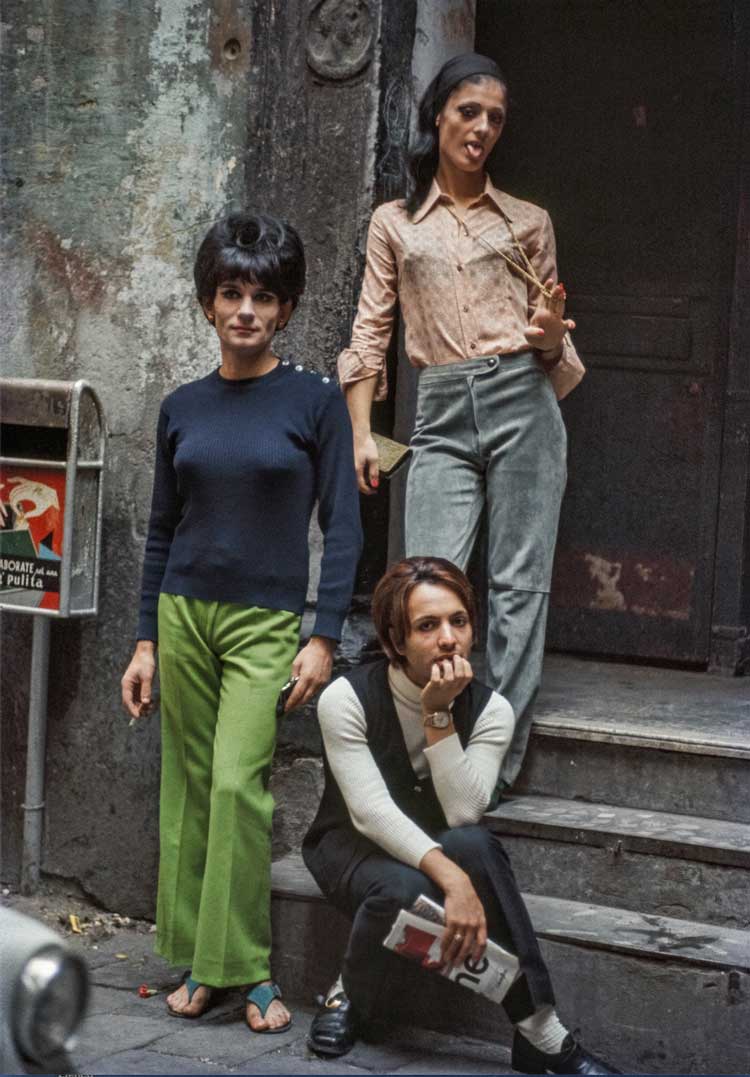
Lisetta Carmi, I travestiti, Genoa, 1965-70. © Martini & Ronchetti. Courtesy Archivio Lisetta Carmi.
The series for which Carmi is best known, however – and rightly so – is I Travestiti (1965-70), to which the entire second gallery space is given over. The curators make clear, in the wall text and in the catalogue, that they are deliberately leaving this title untranslated throughout, owing to the exact English-language equivalent of the term being considered outdated. “In the 60s, travestiti was a generic term for transvestite, transgender and transsexual alike,” explains the co-curator, Giovanni Battista Martini. “The community was indeed a mix of them all, although very few of the subjects had completed their transition. Surgery was not available in Italy.” It was not only not available, but also illegal.
The eight subjects seen here in Carmi’s photographs (there were more, but some did not give permission for the publication of their images due to shame and secrecy) are captured in states of undress as well as fully dressed and glamorously made up – both equally criminal at the time.
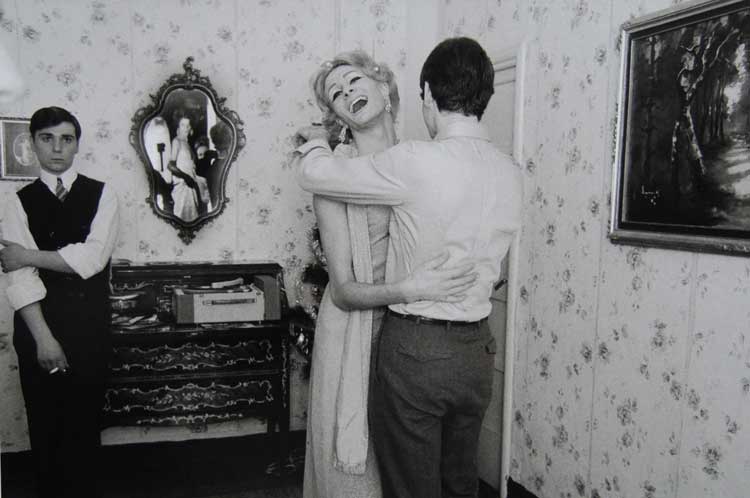
Lisetta Carmi, I travestiti, Genoa, 1965. © Martini & Ronchetti. Courtesy Archivio Lisetta Carmi.
Carmi was introduced to the cross-dressing community, which had made its home in the former Jewish ghetto of Genoa, when she accompanied a friend to a party on New Year’s Eve 1965. She took photos and returned the next day with prints for all her “models”. Over time, she earned their trust and was able to bear witness to their lives as if they were her own. “These individuals (or rather my relationship with them) helped me to accept myself for who I really am,” Carmi was to write in a text to accompany a limited-edition publication of some of the photographs in 1972. “At that time, I, too, was conflicted – perhaps at an unconscious level – about the issue of male and female identity. Now I realise it was not so much the question of accepting a ‘status’ as of refusing a ‘role’.” She was adamant from the outset that she saw only human beings, not men or women.
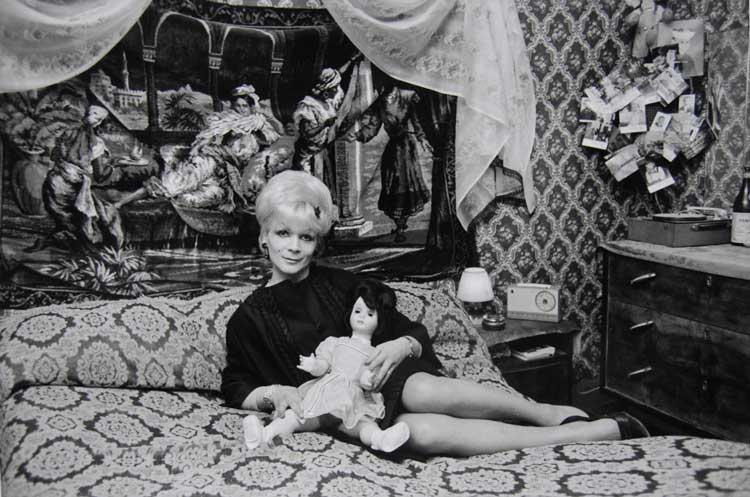
Lisetta Carmi, I travestiti, Gilda, Genoa, 1965-67. © Martini & Ronchetti. Courtesy Archivio Lisetta Carmi.
The series is tender, as are the bodies on show. Gentle mounds swell where nascent breasts are emerging – mostly the result of hormones, but when a subject didn’t have access to drugs, they would sometimes inject melted wax. Doe eyes are outlined in thick black eyeliner, nails are manicured, and cheek bones are razor sharp. Many of the subjects have their arms wrapped around themselves protectively; others are more confident and thrust their hips or part their lips seductively; one or two pose with dolls. Carmi draws us in as voyeurs, but there is no hint of exploitation. Her compositions are painterly, rich in their use of chiaroscuro, and full of tropes such as a mirror reflecting more than what we see before us and framed photographs of the subjects’ better-known selves. The rooms used as the stage set are decadently ornate, while those pictures made outdoors show a crumbling building in a dismal ghetto. This contrast between what is seen inside and outside is hugely metaphoric.
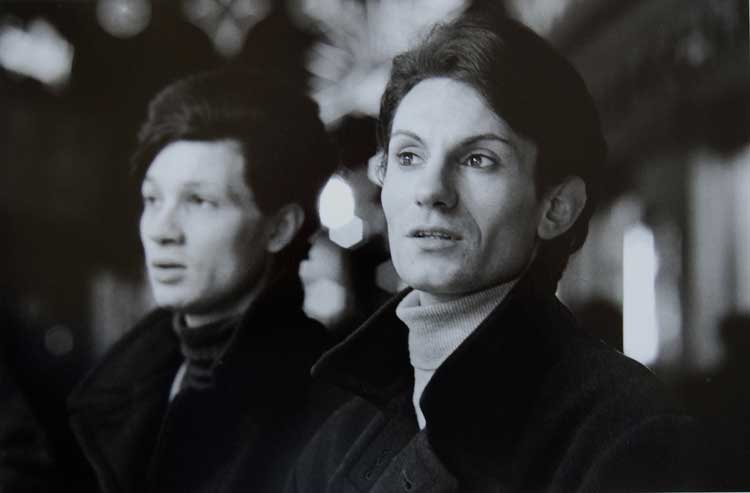
Lisetta Carmi, I travestiti, Genoa, 1965-67. © Martini & Ronchetti. Courtesy Archivio Lisetta Carmi.
Carmi’s intention, when taking these photos, was, from as early as 1967, to publish a book. Despite initial interest, the publisher she was working with withdrew due to the hyped controversy surrounding the subject matter. Carmi didn’t give up and, through a friend, managed to obtain enough money from an advertising company to cover the production costs of 3,000 copies of her book. It was printed on light-pink paper, with grainy enlargements, four pages of contact sheets, an explicit cover and typewritten interviews. The 128 pages of photographs were accompanied by an introduction and short text by Carmi. Although the publication remained largely unsold at the time, it is now a collectors’ item. It has never been reprinted, in accordance with Carmi’s express wishes.
In 2017, Battista Martini was working with Carmi on an exhibition to be staged in Rome. They were in her house in Cisternino (the small village in Puglia where she had been living since the 1970s), where she kept her archives. He opened a drawer and found a folder of colour slides, images of the travestiti, taken at the same time, and in the same place, as her black-and-white photos. Over the next few days, further folders were uncovered, and both Battista Martini and Carmi were thrilled, immediately agreeing that these pictures should be shown to the public. Carmi supervised and signed the prints, and these are on show, alongside their black-and-white counterparts, at the Estorick.
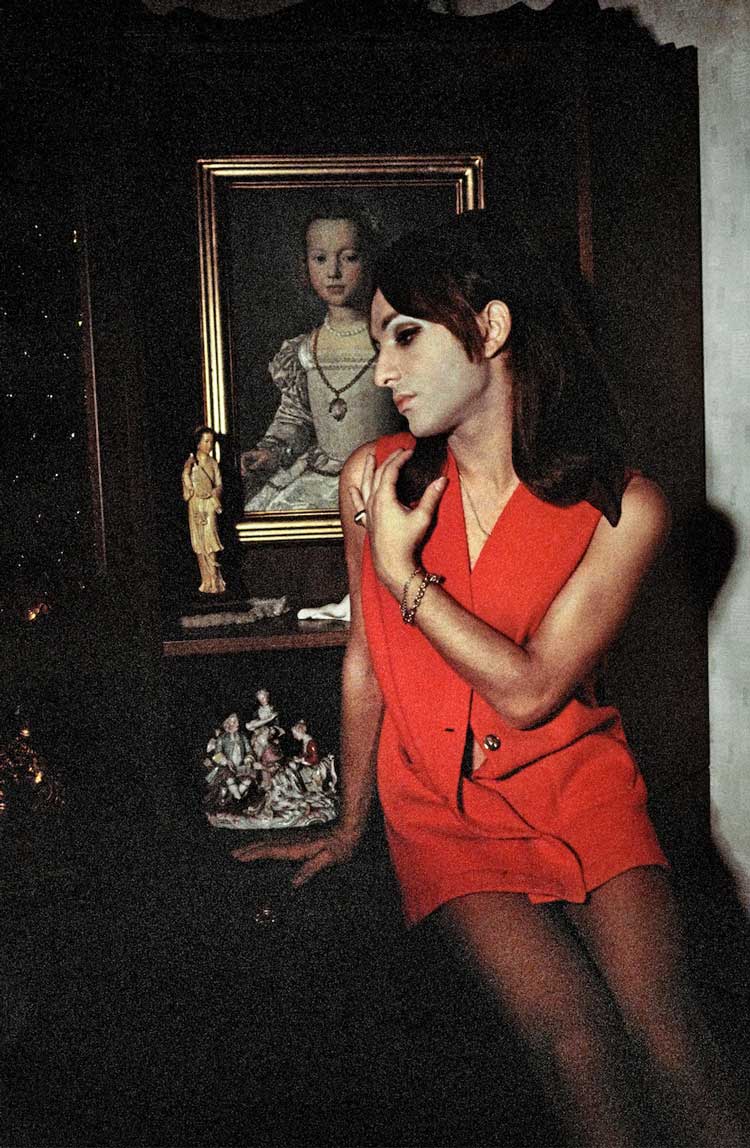
Lisetta Carmi, I travestiti, Audrey, Genoa, 1965-70. © Martini & Ronchetti. Courtesy Archivio Lisetta Carmi.
Battista Martini further went on to publish a second book, 50 years after the original volume, and conceived as “a second chapter” of the 1972 publication. Carmi, despite not wishing to reprint the original, was fully on board with this iteration and approved its layout. Sadly, she died shortly before it was published. In terms of the subjects, Battista Martini says they mostly died young, and, to his knowledge, only one of the black-and-white subjects is still alive. They still live in the same area of Genoa, and, when contacted, agreed to the publication and display of their photographs, both in black and white and colour. The colour images feature one additional subject, Cristina, who hadn’t agreed to be published in 1972 as she was still undergoing her transition. Ahead of the publication of the second volume, however, Battista Martini and Carmi reviewed the photographs with her, and she was happy, this time, to give her consent.
Roberta Cremoncini, the director of the Estorick Collection, sums things up when she says: “For Carmi, photography was not simply an artistic medium but a tool for investigating and comprehending the rich and multifaceted human experience. Her images challenged prevailing social and artistic conventions; nevertheless, whilst deliberately provocative, they were never sensationalist in character, being infused with a profound spirit of empathy and a desire to promote a greater understanding of the world around us.” Perhaps the most succinct closing, however, is this quote from Carmi: “I dedicated myself to photography for 18 years, always alone, and with an interest in and a passion for human beings, focusing on the most extreme situations to be found in this world of ours, which is so unjust yet so fascinating. When they asked me: Who taught you to be a photographer? I answer: Life.”
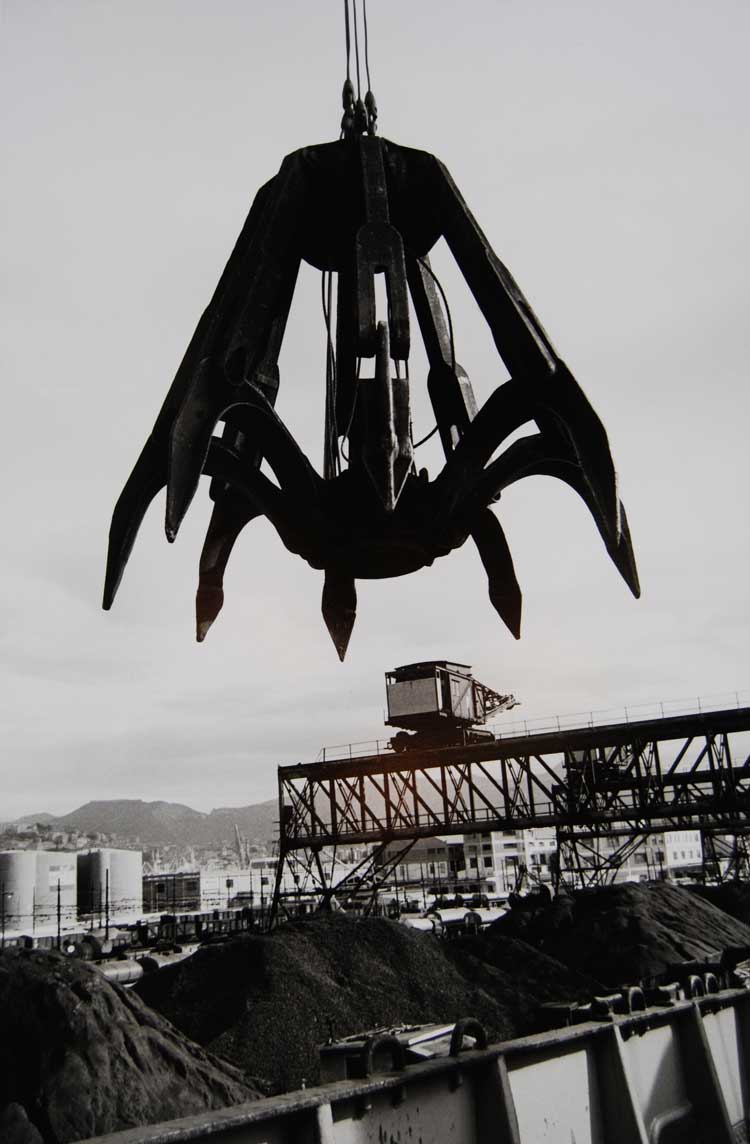
Lisetta Carmi, Genoa - Port, 1964. © Martini & Ronchetti. Courtesy Archivio Lisetta Carmi.